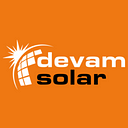How to Connect a Solar System with an Inverter and Batteries
Solar power systems have gained significant popularity as a clean and renewable energy source. They harness sunlight and convert it into electricity and making it an eco-friendly and cost-effective option to power your homes and businesses.
To effectively utilize solar power, it is crucial to understand how to connect a solar system with an inverter and batteries. This article will provide a step-by-step guide on setting up a solar system for optimal performance and energy storage.
Solar Energy Systems
Solar energy systems harness the power of the sun to generate electricity. Unlike traditional energy sources that rely on fossil fuels, solar energy systems utilize photovoltaic technology to convert sunlight into usable energy.
Before diving into the process of connecting a solar system with an inverter and batteries, let’s briefly discuss the components of a solar power system and the benefits it offers.
Components of a Solar Power System
A typical solar power system consists of three main components:
1. Solar Panels
Solar panels, also known as photovoltaic (PV) panels, are responsible for capturing sunlight and converting it into electricity. These panels contain multiple solar cells made of semiconductor materials that generate a direct current (DC) when exposed to sunlight.
2. Inverter
An inverter is a crucial component of a solar power system. Its primary function is to convert the DC electricity generated by the solar panels into alternating current (AC) electricity, which is compatible with the electrical grid and can be used to power appliances and devices in your home.
3. Batteries
Batteries are optional but highly beneficial components of a solar power system. They store excess electricity generated by the solar panels during the day for use during nighttime or periods of low sunlight. Batteries ensure a continuous power supply even when the solar panels are not actively producing electricity.
Also Read: Key Comparison Between Solar Inverters: SolarEdge vs GoodWe
Benefits of a Solar Power System
Utilize a solar power system offers several advantages:
Clean and Renewable: Solar power is a clean and renewable energy source that reduces carbon footprint and dependency on fossil fuels.
Lower Energy Bills: By harnessing the power of the sun, you can significantly reduce your energy bills or even eliminate them.
Energy Independence: Solar power systems allow you to generate your electricity, providing energy independence and protection against rising energy costs.
Long-Term Investment: Installing a solar power system is a long-term investment that can increase the value of your property.
Step-by-Step Guide to Connect a Solar System with an Inverter and Batteries
After a basic understanding of the solar components, let’s delve into the process of connecting them to create an efficient solar system. Follow these steps to ensure a successful connection:
Step 1: Plan and Design
Before you begin the installation process, it’s essential to plan and design your solar system. Consider factors such as your energy requirements, available roof space, and local regulations. Seek professional advice if needed to optimize the design and ensure maximum efficiency. Consult with Australia’s best Solar installer, Devam Solar to Install a solar system at your home or Business.
Step 2: Install Solar Panels
Once the design is finalized, it’s time to install the solar panels. Ensure that they are securely mounted on a structurally sound surface, preferably on your roof or in an open area with maximum exposure to sunlight. Follow the manufacturer’s guidelines for installation and connect the panels in a series or parallel configuration, depending on your system’s requirements.
Step 3: Connect the Inverter
Next, connect the inverter to your solar panels. Locate a suitable location for the inverter, preferably close to your main electrical panel. Follow the manufacturer’s instructions to wire the inverter correctly. Ensure all connections are secure and comply with safety standards.
Step 4: Install the Batteries
If you choose to incorporate batteries into your solar system, install them after connecting the inverter. Position the batteries in a well-ventilated area and follow the manufacturer’s guidelines for installation. Connect the batteries to the inverter using the appropriate cables, ensuring proper polarity and secure connections.
Also Read: How To Charge Solar Battery Directly From Solar Panel
Step 5: Test and Monitor
Once the system is connected, conduct thorough testing to ensure everything is functioning as intended. Monitor the system’s performance regularly to identify any issues or areas for improvement. Utilize monitoring tools and software to keep track of energy production, consumption, and battery storage levels.
Advantages of Connect a Solar System with an Inverter and Batteries
By connecting your solar system with an inverter and batteries, you unlock several advantages:
Energy Independence: With a properly connected solar system, you can reduce your reliance on the grid and become more self-sufficient in meeting your energy needs.
Increased Savings: By generating your own electricity, you can significantly reduce your monthly energy bills and save money in the long run.
Backup Power: Incorporating batteries into your system ensures that you have a reliable backup power source during outages or periods of low sunlight.
Environmental Benefits: Solar energy is clean and renewable, helping to reduce your carbon footprint and contribute to a more sustainable future.
Conclusion
Solar power is a great way to reduce your reliance on the grid and save money on your energy bills. By following the steps in this blog post, you can safely and effectively install your own solar system. Remember to consult with a professional solar mentor like Devam Solar to ensure the highest quality of workmanship and adhere to local regulations and safety standards.
At Devam Solar, we believe in the power of renewable energy and are committed to helping you make the most of your solar investment. If you have any further questions or require professional assistance, don’t hesitate to reach out to our experienced team. Let’s work together to create a greener and more sustainable future.
